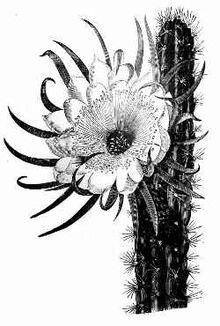Cereus peruvianus
| Peruvian apple cactus | |
|---|---|
 |
|
 |
|
| Drawing of flowering stem | |
| Scientific classification | |
| Kingdom: | Plantae |
| (unranked): | Angiosperms |
| (unranked): | Eudicots |
| (unranked): | Core eudicots |
| Order: | Caryophyllales |
| Family: | Cactaceae |
| Subfamily: | Cactoideae |
| Tribe: | Cereeae |
| Genus: | Cereus |
| Species: | C. repandus |
| Binomial name | |
|
Cereus repandus Haw. |
|
| Synonyms | |
|
Cereus peruvianus |
|
Cereus peruvianus
Cereus repandus (syn. Cereus peruvianus), the Peruvian apple cactus, is a large, erect, thorny columnar cactus found in South America as well as the nearby ABC Islands of the Dutch Caribbean. It is also known as giant club cactus, hedge cactus, cadushi, (in Wayuunaiki) and kayush.
With an often tree-like appearance, the Peruvian Apple Cactus' cylindrical gray-green to blue stems can reach 10 metres (33 ft) in height and 10–20 cm in diameter. The nocturnal flowers remain open for only one night. The fruits, known locally as "pitaya" , Olala (only in some places of Bolivia) or Peruvian Apple, are thornless and vary in skin colour from violet-red to yellow. The edible flesh is white and contains small, edible, crunchy seeds. The flesh sweetens as the fruit opens out fully.
Cereus repandus is an unresearched, under-utilized cactus, grown mostly as an ornamental plant. As noted above, it has some local culinary importance. The Wayuu from the La Guajira Peninsula of Colombia and Venezuela also use the inner cane-like wood of the plant in wattle and daub construction.
Small cuttings of Cereus repandus
Cereus repandus seedling progression
Cereus repandus cutting
Cereus repandus var. monstrose large and dwarf varieties
Cereus repandus (Pitaya) plants in Sde Nitzan (Israel)
...
Wikipedia
